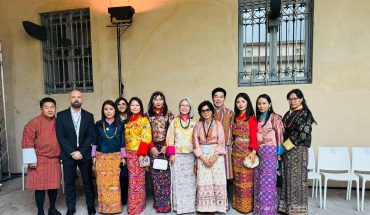
Report reveals young women continue to face a higher unemployment rate of 21.2% compared to 14.5% for men
NGAWANG JAMPHEL
Thimphu
The fourth quarter of 2024 provides significant insights into Bhutan’s labor market as documented in the Labour Force Survey Quarterly Report by the National Statistics Bureau.
Among others, Bhutan maintained a high employment rate of 96.89%, reflecting strong workforce participation.
However, disparities exist, with men enjoying slightly higher employment rates (97.7%) than women (95.6%). Rural areas report better employment outcomes at 98.3% compared to urban areas at 94.5%, due to the reliance on traditional forms of work like agriculture in rural regions.
Among dzongkhags, Lhuentse and Trashigang lead with employment rates of 99.5%, while Paro has the lowest at 93.8%. In thromdes, Phuentsholing has the highest employment rate at 96.1%, whereas Gelegphu lags at 91.3%.
The productive age group (15–64 years) boasts the highest employment at 96.7%, while youth employment (15–24 years) remains a concern at only 82.3%.
Bhutan’s workforce is primarily employed in three key sectors: services, agriculture, and industry. The service sector leads with 43.2% of the workforce, comprising roles in education, healthcare, tourism, and retail.
Agriculture follows at 41.2%, reflecting its importance in rural livelihoods, while the industrial sector accounts for 16.9% of employment, particularly in construction and manufacturing. Gender differences in sectoral employment are pronounced with women predominantly working in agriculture and men more active in the service and industrial sectors.
Further, urban areas feature a greater share of paid employment, particularly in businesses and offices, whereas rural regions depend on unpaid family agricultural workers, most of whom are women.
Regular paid jobs constitute 32.5% of the labor force, with urban areas accounting for 59.7% of these roles. In contrast, 21.6% of workers are family agricultural workers, showcasing rural dependence on traditional labor systems.
The distribution of employed persons across different age groups has maintained the pattern that was observed in the previous quarters. For the productive age group (15-64 years), the employment rate is estimated at 96.7%, with 97.6% for males at and 95.4% for females.
Throughout all four quarters of the survey, it was observed that a higher proportion of females are engaged in the agriculture sector, while a larger proportion of males are employed in the service sector. This pattern highlights the gender-specific trends in employment across different sectors
In the fourth quarter, it was observed that more than one-third of employed persons are classified as paid employees. Among the employed persons in urban areas, majority of them are paid employees, while in the rural areas only 24.8% of them are in the category.
Of the total, approximately 35% of employed persons are classified as “Own account workers”, while 25.3% of them are “family worker” employed either in agriculture or non-agriculture. Among the employed persons working as “wage employees”, 48.2% are males and 25.8% are females.
Additionally, a higher proportion of employed females (31.7%) worked as unpaid family workers in the agriculture sector compared to 15.0% of the employed males.
Of the total of 374,705 employed persons, the majority (50.9%) are classified as “skilled agricultural, forestry, and fishery workers”. While approximately 11.7% are employed as “managers”, and about 8.3% works in “professional” occupational groups.
About one-third of employed persons do not possess any formal education. Approximately 13.8% have completed higher secondary education, while 13.6% have middle secondary education and 11.9% have primary education. Additionally, 9.8% of employed persons reported having a bachelor’s degree or higher.
Bhutan’s unemployment rate, though low at 3.11%, reveals urban-rural and gender disparities. Urban areas face higher unemployment at 5.54% compared to 1.75% in rural regions, highlighting intense job competition in cities.
Paro emerges as the dzongkhag with the highest unemployment rate at 6.21%, while Trashigang and Lhuentse report the lowest rates at 0.46% and 0.50%, respectively.
Among thromdes, Gelegphu records the highest unemployment rate at 8.65%, followed by Thimphu at 5.47%. Youth unemployment is particularly alarming at 17.7%, with young women facing a higher unemployment rate of 21.2% compared to 14.5% for young men.
Unemployment among educated individuals is also notable with a 10.81% unemployment rate for those holding bachelor’s degrees. Women with degrees are disproportionately affected with an unemployment rate of 17.82%, indicating a mismatch between educational qualifications and available job opportunities.
Despite the country’s strong overall employment rate, several challenges persist. Youth unemployment remains a critical issue, particularly in urban areas where job competition is fierce.
The report also delves on the urban-rural disparities which highlight the unequal distribution of job opportunities with rural areas relying on traditional unpaid agricultural labor and urban centers struggling with higher unemployment rates.
Further, gender inequality continues to pose barriers for women, especially in high-paying sectors like services and industry. The high unemployment rate among educated individuals underscores a significant gap between education and the job market, as many graduates struggle to find jobs aligned with their qualifications.
To address these challenges, the report states that Bhutan must implement targeted policies and programs. Creating job opportunities for youth through entrepreneurship, vocational training, and skills development programs is crucial. Economic diversification into sectors like technology, renewable energy, and creative industries can also create sustainable jobs.
“Bridging the gap between education and employment is essential, requiring the education system to align with labor market needs by offering relevant courses and practical training opportunities,” the report states.
In addition, the report also subtly points that gender inclusivity must also be prioritized, with policies ensuring equal pay, flexible work arrangements, and support systems like childcare to help women enter and remain in the workforce.
“For rural areas, improving infrastructure and diversifying livelihoods beyond agriculture can provide more paid employment opportunities.”





